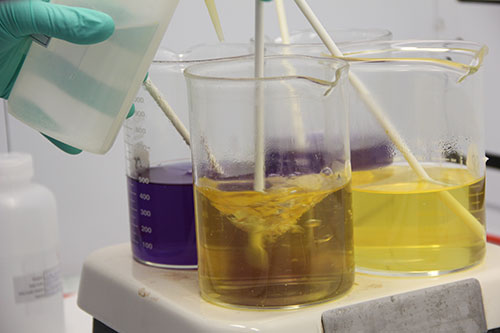
Alpha-emitting radionuclides are co-precipitated with iron hydroxide using a color indicator, bromocresol purple, and a strong base, ammonium hydroxide.
Radionuclides can be harmful to human health if inhaled or ingested. They are commonly present at low concentrations in geological formations, produced at low levels through interactions between the atmosphere and cosmic radiation, and are produced artificially through human activities, such as power generation, medical therapy and heavy industry.
The Radiochemistry section primarily performs analyses of water and soil to determine radioactivity concentrations, but also is capable of analyzing air, food, milk, urine and foliage. The section maintains preparedness for any radiation emergency response incidents.
HIGHLIGHTS
- Turnaround times for highest volume tests either improved or remained the same in FY17 as compared to FY16. Median turnaround time for one of SHL’s highest volume tests – gamma spectrometry – decreased from 14 days in FY16 to 5 days in FY17, representing a 64 percent improvement in overall turnaround time.
- Performed extensive surveillance for radionuclides in food products as part of the Food Emergency Response Network (FERN).
- All three full-time radiochemistry staff members received SHL Exceptional Performance awards for dedication and accomplishment.
- In collaboration with researchers at the University of Iowa, Radiochemistry supervisor Dustin May published three peer-reviewed journal articles, focusing on new method development and analysis of the environmental impacts of drilling and mining wastes on the environment.
- May, D., Nelson, A.W., Schultz, M.K. (2017). Quantitation of Lead-210 (210Pb) Using Lead- 203 (203Pb) as a “Massless” Yield Tracer. Journal of Environmental Radioactivity, 171, 93-98. DOI:10.1016/j.jenvrad.2017.02.003
- Nelson A.W., Eitrheim E.S., Knight A.W., May D., Wichman M.W, Forbes T.Z., Schultz M.K. (2017). Polonium-210 Accumulates in a Lake Receiving Coal Mine Discharges— Anthropogenic or Natural? Journal of Environmental Radioactivity, 167, 211-221. DOI:10.1016/j.jenvrad.2016.10.023
- Eitrheim, E.S., May, D., Forbes, T.Z., Nelson, A.W. (2016). Disequilibrium of Naturally Occurring Radioactive Materials (NORM) in Drill Cuttings from a Horizontal Drilling Operation. Environmental Science & Technology Letters, 3 (12), 425–429. DOI:10.1021/acs.estlett.6b00439
- Combined radium
- Gross alpha radiation
- Gamma spectrometry
- Tritium
- Gross beta radiation



